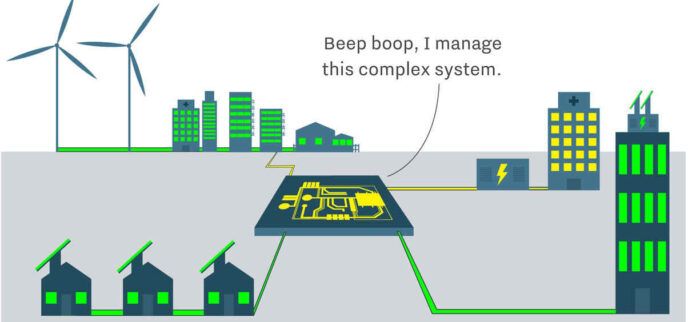Integrating Wind Energy Solutions into Building Architecture: In today’s world, sustainability is at the forefront of design considerations for office buildings, homes, and schools. One promising innovation is the integration of wind energy solutions into building architecture. This emerging trend addresses the growing demand for renewable energy and aligns with environmentally-conscious practices. Whether for commercial office spaces, residential homes, or educational institutions, incorporating wind energy into building designs provides an efficient and eco-friendly way to power structures.
The Importance of Renewable Energy in Modern Architecture
Modern architecture is evolving beyond aesthetics and functionality; it now encompasses sustainability. As energy consumption continues to rise, particularly in large office buildings and schools, there is an urgent need to adopt energy-efficient solutions. Wind energy is one of the cleanest renewable energy sources available, with the potential to offset significant amounts of carbon emissions when integrated into building design.
Key benefits of wind energy integration:
- Reduction in greenhouse gas emissions
- Long-term energy cost savings
- Independence from non-renewable energy sources
- Enhanced energy resilience and reliability
By strategically incorporating wind energy into building architecture, designers can reduce reliance on traditional power grids and help meet sustainability goals for various types of buildings.
Wind Energy Solutions for Office Buildings
Incorporating wind energy into office buildings is not only feasible but also highly advantageous. Office towers and corporate buildings often have large roof areas, which can be utilized to install wind turbines. This can lead to substantial energy savings, especially for businesses looking to reduce their carbon footprint.
Examples of wind energy in office architecture include:
Rooftop wind turbines: Installing small-scale turbines on the roof of office buildings can generate a significant amount of electricity, which can power lighting, HVAC systems, or even computers.
Building-integrated wind turbines (BIWT): These are designed to become part of the building’s structure, making them both functional and aesthetically pleasing. Turbines can be placed within a building’s facade or integrated into the rooftop, becoming a seamless part of the design while generating clean energy.
For office buildings, the use of wind energy solutions reduces operating costs and supports corporate social responsibility (CSR) goals. Integrating wind energy technology can also add a unique, forward-thinking identity to the brand.
Wind Energy Solutions for Homes
The residential sector is also benefiting from the integration of wind energy. Homeowners who are looking for ways to reduce their energy bills and decrease their environmental impact are increasingly turning to small-scale wind turbines. When wind energy is incorporated into home architecture, it can significantly reduce household reliance on grid electricity.
Considerations for home integration include:
Micro wind turbines: These small turbines are suitable for homes with enough space for installation. They can be placed in gardens, on rooftops, or even on walls, and provide supplementary energy for everyday use, such as powering appliances and lighting.
Hybrid systems: Homeowners often combine wind energy with solar energy to create a hybrid system, optimizing power generation based on weather conditions. This allows for consistent energy production throughout the year, regardless of sunlight or wind availability.
Integrating wind energy in homes helps households achieve energy independence and contributes to long-term cost savings.
Wind Energy Solutions for Schools
Schools, particularly large campuses, are ideal candidates for integrating wind energy solutions. With rising energy costs and a strong push toward sustainability in education, wind turbines can serve both functional and educational purposes. In addition to supplying power, these systems can become teaching tools, allowing students to learn firsthand about renewable energy.
Applications in educational settings include:
Wind turbines on school campuses: Schools can install larger turbines in open spaces such as schoolyards, where wind conditions are favorable. The energy generated can power lighting, HVAC systems, and computer labs, making the institution more sustainable.
Educational opportunities: Wind turbines on school campuses can be used as hands-on educational tools, demonstrating the principles of renewable energy to students in science, technology, engineering, and mathematics (STEM) programs.
By adopting wind energy solutions, schools can reduce operational costs, achieve sustainability goals, and provide students with a practical understanding of renewable energy.
Design Considerations for Wind Energy Integration
Successfully integrating wind energy solutions into building architecture requires careful planning and consideration. Designers and architects need to assess factors such as wind patterns, building orientation, and local regulations. Additionally, aesthetics play an important role—wind turbines can be designed to complement the architectural style rather than detract from it.
Key design considerations include:
Location and wind resources: Buildings in areas with strong and consistent wind patterns are best suited for wind turbine installation.
Noise and vibration: Wind turbines, particularly in urban areas, need to be designed to minimize noise and vibration.
Maintenance: Regular maintenance of wind turbines is essential to ensure optimal energy production and longevity.
Conclusion
Integrating wind energy solutions into building architecture is an effective way to achieve sustainability in offices, homes, and schools: baut – mur. Wind energy not only reduces carbon emissions and energy costs but also offers an innovative design element that highlights a commitment to renewable energy. By thoughtfully incorporating wind turbines into architectural designs, we can create buildings that are not only functional and beautiful but also eco-friendly and energy-efficient.
As the demand for renewable energy grows, integrating wind energy solutions into building architecture will undoubtedly become a critical aspect of sustainable design practices across all sectors.
